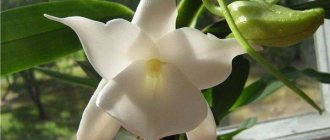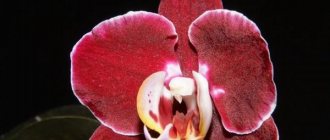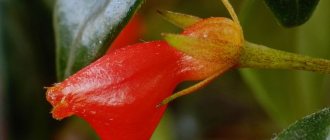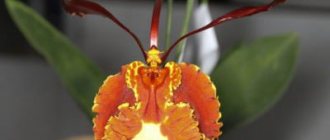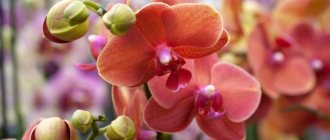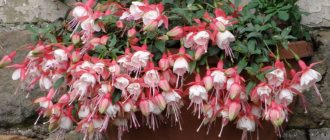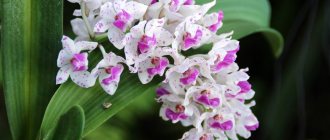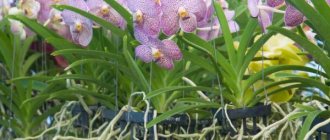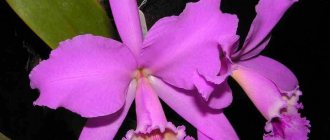The Orchid family includes several genera:
- oncidium;
- tolumnia;
- psychopsis;
- Odontoglossums.
Most of them grow on trees, that is, they belong to epiphytes. A small number of species grow on rocky, rocky soils - these are lithophytes.
The natural habitat of the genera in question is a warm, moderately humid climate, with diffuse sunlight.
Garden and indoor varieties and hybrids originated from wild representatives :
- tropical;
- forest species from the central, middle and northern latitudes (136 species - Lyubka bifolia, orchid, lady's slipper, bulbous calypso, swamp moth, spreading orchis).
Northern forest orchids are currently included in the Red Book. Their roots produce a fungus - mycorrhiza, which is involved in the metabolic process. Replanting forest orchids is problematic.
Garden crops develop and bloom well in conditions that are balanced for them. Next, you will receive comprehensive information about the varieties of orchids: Leopard, Bat, Ophrys, Psychopsis.
Leopard orchid
While preparing information on this topic, we were never able to determine exactly what people mean when searching for the Leopard Orchid plant. There are several possible variants of plants that may be implied by this name:
Lily Belamkanda
, the Belamkanda Chinese lily, which is scientifically considered generally an iris (Iris domestica), migrated to our gardens . A perennial with a long flowering period in the garden, it reproduces by self-sowing or dividing the rhizome.
Flower diameter up to 7 cm, flowering period from July to September. The lifespan of an individual flower is 2 hours; when it fades, it curls.
Balakamda sinensis (Iris domestica).
The seed pods form in the fall and resemble blackberries. A young flower can be grown at home and then moved to the garden.
One of the variants of Odontoglossum
Odontoglossums (lat. odontos - “tooth” and glossa - “tongue”) are an epiphytic orchid that emerged from the mountainous regions of Central and South America.
Odontoglossum "Leopard Lily" is shaped like a star. The color of the petals is varied, but the pattern is recognizable, similar to the skin of a leopard. Some varieties have the aroma of lily of the valley or vanilla.
Bicton odontoglossum.
Many species of odontoglossums are used for crossing with other genera (Miltonia, Oncidium) to obtain new hybrids with new colors and scales of flowers. Natural species of Leopard orchids are extremely rare in flower shops.
Orchids in “leopard skins” bloom from October to May on the windowsill at home. The rest period is accompanied by a decrease in temperature to 20 degrees and a decrease in the amount of watering; humidity is kept at least 60%. They are easier to care for compared to other types .
The substrate for transplanting a leopard orchid must necessarily contain bark and peat at a ratio of 3 to 1.
Relatives of leopard orchids are “Tiger orchids”, which belong to the genus Rossioglossum. They are able to bloom from late autumn to late winter.
Leopard orchid: what kind of flower is it?
Mostly hybrid varieties are kept in greenhouse and indoor conditions. Breeders are constantly adding new products to the list, and it’s not easy to keep track of it. Under the name “leopard” orchid, the following can be found on sale: Leopard Prince (Prince), Yellow Leopard, Golden Leopard, Chinese belamkanda.
Growing in nature
All indoor and garden hybrid varieties have wild ancestors. Most of them live in warm tropical or subtropical climates. They feel comfortable in moderate humidity and diffuse sunlight. Most often, representatives of the Orchid family are found in Southeast Asia, the Philippines, and Indonesia. There are also varieties that grow in central, middle, and even northern latitudes.
Ofris
Orchid Ophrys (ancient Greek όφρύς - “eyebrow”) is a perennial herbaceous plant from the orchid family , there are more than 150 varieties. Ofris is protected by the Red Book.
Root tubers have a spherical appearance. The leaves are collected in rosettes. Inflorescences are racemes. The flower looks like an insect, the lip is bright and pubescent.
Ophrys insectiferous.
The growing area is quite wide:
- Mediterranean;
- North Africa;
- Asia Minor;
- Southern and Central Europe.
Insectiferous orchid grows up to 35 cm in height. The insectiferous orchid has a spike-shaped inflorescence and an erect flower. Flowers are like insects that have folded their wings. The leaves are red-brown, and the lip is three-lobed with a bluish spot in the middle. The flowering period of ophris is from June to August.
The bee-bearing ophrys grows up to 45 cm. There are from 3 to 8 rare flowers on the peduncle.
The perianth leaves are pink, the green inner petals are short and velvety. The color of the lip is purple-brown with a yellow-brown spot, and there is a yellow border along the edge.
Ophrys bee-bearing plant blooms from May to June. After flowering, a fruit is formed - a capsule.
Decorative orchids are propagated by seeds.
Ophrys bee-bearing.
Important! When keeping a flower at home, keep in mind that opris is self-pollinating and has cross-pollination.
Ofris's homeland in Russia is located on the Black Sea coast of the Caucasus and in the Caucasus. The plant lives in oak and juniper forests and on limestone screes near the mountains. Ophrys is endangered.
Video with a detailed description of the types of Ofris:
Psychopsis
Previously, the psychopsis orchid (Greek psyhee - soul, “butterfly” and opsis - “similar”) belonged to the genus Oncidium. Currently, it is a separate genus with its own species and subspecies. The homeland of psychopsis is America, its center and south with a temperate warm climate.
The structure of a psychopsis flower is a copy of a butterfly or moth. The Greek goddess Psyche is often depicted in myth as a fairy with butterfly wings.
The orchid forms unifoliate pseudobulbs with a long peduncle. Large flowers open in a “revolving” type, that is, as the previous one fades.
At home, psychopsis develops and blooms well. A temperature regime is created for them in which the difference between day and night temperatures does not exceed 5-6 degrees. On the windowsill, this genus of orchids can bloom all year round. In nature - from March to October.
Psychopsis orchids have several varieties , below you will learn about the most popular of them.
Papilionaceous
grows up to 28 cm in height It forms oval-round pseudobulbs up to 5 cm, grow closely, often with dirty red spots and specks.
Psychopsis moth.
Each bulb produces one erect leaf up to 23 cm in length. The color of the leaves is matte with veins and red spots.
The flower reaches 15 cm in length.
Kramer's Psychopsis
The epiphyte grows up to 29 cm. Pseudobulbs are formed up to 4 cm, located tightly to each other.
Dark green leaves, sometimes with a marbled pattern, of Kramer's psychopsis (Psychopsis krameriana), up to 25 cm in length, grow on the tops of the pseudobulbs, the leaves are leathery with sharp tips.
The diameter of large flowers is up to 12.5 cm.
Kramer's Psychopsis.
Limminghei (Orchid Psychopsiella limminghei)
Miniature epiphyte , which grows heart-shaped pseudobulbs no more than 2 cm in length. Leaves appear at intervals of 1-2 cm. Thin, light brown-green leaves each up to 4 cm in length with burgundy spots.
The orchid produces up to five 10-centimeter peduncles with a single flower. Flowering according to the “revolving” type. Butterfly flower up to 4 cm in diameter.
Limmynhey.
Sander (Oncidium Sanderae)
A sympodial epiphyte, forming groups of plants, grows no more than 25 cm . Pseudobulbs are matte green, ovoid, up to 4.5 cm in length.
The leaves are leathery, oval, up to 20 cm long at each tip of the bulb. Peduncles are erect, up to 35 cm long. Each arrow produces about 4 flowers up to 15 cm in length , which bloom alternately.
Blooms several months a year.
Psychopsis Sander.
Alba (Psychopsis Kalihii alba)
An epiphyte with a long peduncle up to 120 cm. On each peduncle, 1-2 butterfly flowers of delicate yellow colors with orange spots along the edges are formed.
The diameter of the flower reaches 8 cm, each of them blooms for about two weeks.
Alba.
Video description of the Psychopsis orchid:
Mysterious orchid
- VK
- Youtube
Each plant has its own energy and the ability to influence human consciousness, giving rise to various images, feelings and associations.
And, of course, people have always associated plants with the mysterious world of the supernatural, that which cannot be seen with physical vision, that is accessible only to spiritual vision.
The appearance and mystery of Flora's children prompted the creation of chilling stories and legends. With the appearance of orchids in human life, people began to attribute to them various mystical properties, both good and evil.
So, the first journey we will make in search of magical stories and mysterious rituals will be Southeast Asia. It is this part of the world that is home to the genus Grammatophyllum, which includes about 12 species of terrestrial and epiphytic plants.
One of the largest existing representatives of the orchid Grammatophyllum speciosum. The pseudobulbs of this plant can reach three meters in height, and the inflorescences of hundreds of flowers can be up to 2 meters wide. It is amazing that such a plant can weigh about 1 ton in its entirety.
Grammatophyllum speciosum has been found in the Philippines, Borneo, Sulawesi, New Guinea, the Moluccas and Solomon Islands. Each inflorescence of this plant, up to a meter long, has about sixty large yellow-green with reddish-bronze spots on the petals and sepals of dense flowers.
Local residents used the seeds of this plant to prepare a love potion. The natives of the Moluccas have always believed that if you mix these seeds into a woman’s food, she will fall in love forever.
In the remote mountainous regions of Papua New Guinea live the Chimbu people, who gave the name to one of the species of dendrobium “duruagle”, which means “woman of easy virtue”.
There is a local legend that tells that at night the ghost of a lonely, beautiful naked woman wanders near lakes and ponds and lures young men into her arms.
If the young man fails to satisfy this beauty overnight, then he wakes up, awarded with a whole bunch of sexually transmitted diseases. These sores can only be cured by preparing a special medicine from Dendrobium duruagle.
Our further path lies to Africa. In the tropical zones of this continent, magnificent orchids of the genus Ansellia grow. This genus got its name from John Ansell, who first discovered the flower on the trunk of a palm tree on the island of Fernando Po in 1841.
He named this flower Bioko. One of the representatives of this genus, Ansellia africana, has magnificent yellow flowers with red spots, which is why it is also called the leopard orchid.
European explorers saw Zulu youths attaching the leaves of this beauty to their shoulders. From this same leopard orchid, Africans prepared a healing decoction used for various purposes, including as a means to improve sexual activity.
The roots of the plant were burned to ward off bad dreams. A paste made from pseudobulbs was used by unmarried women as a contraceptive for one night. Fortunately, such barbaric methods did not cause much harm to people's health.
Love is the only and greatest aspiration of every person, the goal and meaning... That is why in occult practice, matters of the heart have always been a favorite topic and the most popular, and the most in demand were decoctions, potions and potions for love spells.
In ancient times, there were rumors that witches used orchis tubers in a decoction recipe, which was prepared from a fresh tuber and used to strengthen true love and drive away false passion.
Much attention in ancient sources is paid to the topic of expelling evil spirits with the help of orchids. The Chinese treatise “Questions of Medicine” of 1590 says that orchids are widely used to expel negative forces. The Chinese character for orchid is lan, which literally means shelter or getting close to someone or something.
The ancient Greek physician, botanist and pharmacist Pedania Dioscorides, who lived in the first century AD, writes in his writings that the orchid has the ability to ward off dark forces.
Many anthropological sources talk about the suitability of orchids in the fight against evil spirits and forces of darkness. There is information about a broom made from pseudobuds with leaves of some types of dendrobium, which was recommended to sweep the room immediately after the death of someone in the family. They claimed that if this was done in time, then death would no longer visit this house.
Often, various parts of orchids were used in ancient times as talismans and amulets. For example, in India, where snakes have always been the biggest problem and danger, the only means of protection against their bite has always been considered to be wearing a belt or necklace made from dried pseudobulbs of the Eulophia orchid.
The Solomon Islanders attached parts of a dendrobium orchid to their heads, which they believed would keep them safe when entering any unfamiliar or dangerous territory.
But dendrobium flowers, shaped like dog heads, were added to dogs’ food to increase their courage and endurance during the hunt.
Orchids were often used as a talisman by treasure hunters. In Mexico, Vanilla planifolia was used as a plant that patronizes and protects travelers.
But seekers of buried treasures have always protected themselves from danger by keeping orchid tubers with them. The Scots made amulets from the tubers of Orchis mascula.
The people of Norway believed that if the finger-shaped tubers of Dactylorhiza majalis were collected before St. John's Day, they would have the magical power of five lobes at that time. If these same tubers are hidden under the threshold of the house on the same day, then it is reliably protected from damage and the evil eye.
As you can see, the exquisite appearance of orchids and the mysterious way of their life have long attracted the attention of people, exciting the imagination and giving rise to all sorts of beliefs and myths.
Today, the orchid is one of the most popular and beloved flowers on the planet, having won the favor of the most influential and discerning people.
discuss the article on the forum
Date of publication: March 04, 2009
0 comments
Boguslavsky Egor
If you notice an error, select the required text and press Ctrl+Enter to report it to the editors
Comments:
There are no comments yet, you can add your own comment. For this you need to register or log in.
Authorization
You have entered an incorrect login/password
adding a comment
Bat plant
Many exotic flowers have unusual shapes and colors. The Bat flower itself is an inflorescence. The bat is sometimes called the "Devil Flower", "White Dove" or "Bat Flower".
The unique plant has nothing in common with orchids and belongs to the Tacca family , which grow in life in the south and east of Asia, India, Malaysia and the south of America with varied climatic conditions:
- open or shaded bushes;
- seashore and savannah;
- rainforests and high mountains.
Tacca is a perennial plant with creeping or tuberous roots that can grow on any soil: sand, stones, gravel, loam, clay, limestone and even volcanic rocks. The height of the plant is from 40 to 100 cm, some species stretch up to 3 meters.
Few large basal leaves and inflorescences are formed on the flower. These include only three species; the flowers differ in the upper pair of bracts.
The flowers of Takka Bat in an umbellate inflorescence are bisexual and are located on small pedicels with long thread-like “whiskers”. The spathe consists of four bracts in two circles. The fruit is a berry with seeds up to 5 mm long.
At home, the takka bat is extremely rare. She prefers western and eastern windows, without direct sunlight. Northern window sills will require additional lighting. In the spring and autumn of the Bat, the temperature is maintained within 25 degrees.
Takka "Bat".
Important! Drafts are detrimental to the Bat Taka.
From this video you will learn how to care for Takka the Bat:
Description of the plant and photo
The tiger orchid has a special charm due to its “predatory” coloring.
The orchid is a plant of the flowering division, the class of monocots.
The natural climate zone for the tiger orchid is the forests of Guatemala and Costa Rica.
Appearance
The foliage of this flower is oblong in shape, and the lower part is covered with numerous specks of dark brown color. Flowering duration is one month. Tiger orchids can be of different colors , be it yellow, white, red with an unusual splash.
Home care
Tropical conditions are created for a tropical beauty on the windowsill. The room temperature is maintained from 20 to 27 degrees. Air humidity is created within 60-80% using spraying and additional containers with water.
Attention! Spray should be done carefully, without getting water into the axils of the leaves.
Lighting is required to be bright, without direct sunlight.
Watering is not a method of hydration. There should be little water in the pot. The next watering is done only after the substrate has dried.
Stress stimulates the orchid to bloom: a sharp decrease in the number of spills and a decrease in air temperature by 5-6 degrees.
For each variety there are separate nuances in content. Before purchasing orchids, you need to study them.
It is best to feed orchids with special fertilizers according to the instructions: little by little, but weekly.
Disease prevention involves strict adherence to watering, humidity, temperature and lighting regimes.
Care instructions
- Choosing a location . The plant must be placed near a south or east window.
- Preparing the pot and soil. To prepare the soil you will need:
- Sphagnum moss. If it is not available in stores, you can take regular moss.
Pine bark. If you can’t buy it, you can pick it from fallen trees. You cannot take pieces affected by bark beetles.
- Fern rhizomes. They contain exactly the nutrients that the orchid needs.
- It is advisable to add walnuts and charcoal to the soil.
- Temperature . During the day it should be 20 - 24 degrees Celsius, and at night 15 - 18.
- Humidity . Home conditions for the plant are quite suitable. Don't forget to spray it in the summer. Do not spray in cold weather.
- Lighting . An orchid needs light. It is absolutely necessary for the opening of the buds. You can use an artificial lamp.
- Watering . The tiger orchid prefers dry soil rather than wet soil. Watering in summer - 2 times a day, and in winter - once.
- Feeding . Additives must not be applied when the plant is sick, blooms, or in the first month after transplantation.
- Transfer:
- moisten the pot to make it easier to remove the bush;
- clean the roots from moss and other things;
- rotten shoots - remove;
- the roots must be washed with heated water;
- cover the wounds with crushed coal and let dry for 20 minutes;
- pour drainage into the pot and then some fresh soil;
- after this, the plant is placed in the center of the pot and covered with the remaining soil;
- After all procedures, water well.
The pot must be spacious. The bottom is stable and has holes. Pebbles or other drainage should occupy approximately 25 percent of the container.
Landing rules
The soil for all varieties of orchids is made water-permeable and breathable. The substrate must contain large elements:
- sand;
- bark;
- moss;
- stones;
- pebbles.
A third of the height of the pot is occupied by drainage. Experienced gardeners recommend using a transparent pot to better control the condition of the root system. Orchids are replanted no more than once every two years using the transshipment method.
Orchid transplantation step by step.
